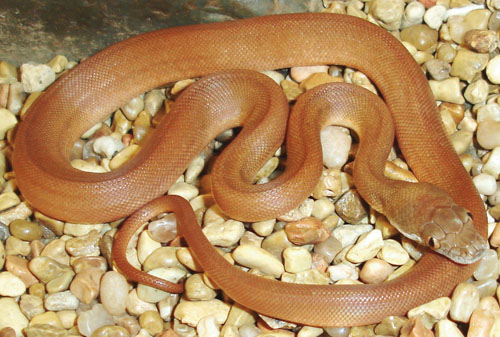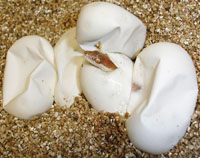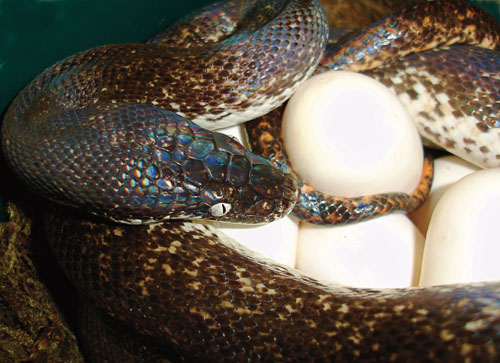The Savu python from the island of Sawu in the Indonesian archipelago is easy to maintain yet tricky to breed
Of the currently recognized 53 taxa of pythons, the Savu python (Liasis savuensis) is about the fourth smallest species. My largest female is 4 feet 9 inches long, and my largest male is 3 feet 9 inches. Although capable of growing longer, these sizes are typical of mature adults.
One of this snake's most interesting traits is that the adults have large, white eyes. Given its appearance, it is easy to see how this snake earned another common name when first imported into the United States in the early to mid '90s – the white-eyed python. At that time, the species was so new to captivity that it did not have an accepted common name, and several different varieties were used. Today, the species is most often referred to as the Savu python.

Savu pythons come from the small island of Sawu. The name was spelled Savu back when the Dutch governed most of Indonesia, and this is still seen in some accounts.
Adults are usually a dark, brownish-black with some lighter, brownish-orange speckles. The belly is primarily white and orange speckled, with some of the orange coming up along the sides. The beautiful scales are highly iridescent, making the Savu python quite appealing.
These snakes go through an extreme color change. Hatchlings begin life with a predominantly orange-brown or terracotta color. This coloration is the same for the hatchling's eyes. The color change takes more than a year to complete, and some specimens retain more of the orange color than others. I would not be surprised if selective breeding for high-orange coloration could produce some interesting results.
Habitat and History
Savu pythons come from the small island of Sawu. The name was spelled Savu back when the Dutch governed most of Indonesia, and this is still seen in some accounts. In fact, "Sawu" is correctly pronounced as "Savu," so to change the common name to the Sawu python would seem to be unnecessarily confusing.
Sawu is a small island roughly 10 miles long and 6 miles wide, located between Sumba and Timor, on the southern edge of the Savu Sea. This area is north and slightly west of Australia's N.W Coast. At about 10 degrees south latitude, it is a tropical locality, but the island is relatively dry compared to most of the islands in the Lesser Sundas of Indonesia. The topography is low, rolling hills of grasslands and scrub with some small patches of forest. The highest elevations on the island are several high hills, which are about 984 feet above sea level, but most of the island is less than 492 feet in elevation.
This species is only known from Sawu, making it the python species with the smallest known natural range. It seems possible that specimens may also be found on the small nearby island of Raijua, located less than a mile offshore from the west end of Sawu, but no investigation of the herpetofauna of that island has been published.
Unveiling the Mystery
Very little has been published about Savu pythons in the wild other than some anecdotal information from individuals who have traveled to Sawu Island. I've been told that Savu pythons have been found near the highest elevations on down to the driftwood along the high-tide mark on the beaches. Apparently, the species can be found over the entire island. Heavily collected for the pet trade for several years, the current wild population status is unknown at this time. Although farm-bred animals occasionally enter the trade from Jakarta, it has been more than a decade since wild-collected Savu pythons have been imported. As one of the last great python species discoveries, it was described in 1956. At that time, it was named Liasis mackloti savuensis, a subspecies of the freckled python. There are no records I can find of live specimens in captivity anywhere in the world until the first importations to the United States in 1993. At the time, the pythons were a surprise to the herp community and a huge hit among reptile hobbyists. The wild-caught adults proved to be easy going, mellow snakes, and they settled into captive life well.

As each baby left its egg, I washed it off in the sink with lukewarm water to remove any clinging vermiculite. Hatchlings were housed individually in a rack-style setup similar to the adults, only the enclosures were smaller.
Breeding Savu pythons in captivity was another story. Like most wild-collected adult pythons, the wild-caught adult Savus proved difficult to breed in captivity, and very few keepers were able to reproduce any from those first imports. Fortunately, a few initial successful breeding projects of the wild-caught adults yielded the next generation F1, captive-bred animals. This first captive-hatched generation of pythons proved far easier to breed and enabled exponential growth of the captive population.
Although the availability of quality captive-bred and captive-hatched animals began to further establish the Savu python in captivity, a competing interest was simultaneously growing in the hobby – that of breeding rare snake morphs, especially ball pythons. Keepers who were working with Savu pythons decided to sell their snakes and replace them with far more common species, such as the ball python, that had greater commercial value and a much bigger audience demand. Luckily, the Savu python has not disappeared from the pet trade altogether, and the future of this species in captivity should be encouraged.
Housing and Care
Keeping Savu pythons could not be easier, and their relatively small size makes them ideal pythons for apartments or small homes. I have a large collection of pythons, so I prefer rack-style housing, but standard cages can also be used. My adults are kept individually in plastic bus tubs normally used for the food-service industry. Each tub measures 22 inches long, 15 inches wide and 5 inches tall, and is placed in a custom-made plastic rack system. Heat cable is set into a groove under each cage toward the back of the rack, providing a warmer basking area.
The ambient temperature in my snake room is fairly stable, ranging 80 to 82 degrees Fahrenheit for most of the year. Basking temps are kept around 86 to 90 degrees (this supplemental heat is usually only used by gravid females). Keepers without a temperature-regulated (/reptile-health/heating-cooling.aspx ) snake room will need to boost temps in their snake's cage, whether it is provided by a heat lamp, reptile heat pad or heat panel. Experiment with all the options to find out which work best within your specific setup.
I keep my snakes on aspen bedding, but cypress mulch and newspaper also work well. I spot clean messes on a weekly basis and change out the entire substrate every few weeks. I mist the snakes with a fine spray of water during their shed cycle because I live in a dry climate. Failure to spray the snakes can lead to shedding issues. I keep my snakes in tubs that they cannot see through, making hides unnecessary. However, if you use clear enclosures, offer snakes a hide large enough for them to coil their entire body inside to help them feel secure.
Eager Eaters
Savu pythons readily accept commercially raised mice or rats, though I feed only mice to mine throughout their lives.
Adults are given one large/jumbo mouse about every two weeks. Babies and juvenile snakes are fed appropriately sized meals once a week. I offer my snakes rodents that are no more than a little larger than a snake's thickest point. Keep clean, fresh water in the enclosure at all times. A ceramic water bowl measuring 5 inches in diameter is a good choice.
Breeding Savu Pythons
These pythons can grow to adult size in two years, but in my experience they do not show much interest in breeding until they're 3 to 5 years old. To successfully breed this species, you'll need to provide a cool-down period. At this time, house them singly. Starting in October, begin lowering the nighttime temperature a few degrees every couple of nights. Do this until, after a few weeks, the nighttime lows are maintained at 72 to 74 degrees Fahrenheit, and the daytime highs remain at a constant 80 to 82 degrees. Keep the lights on for 12 hours a day, and maintain the above temperatures until mid December. Then gradually begin raising the nighttime temps back to their normal levels. By the end of December, the cooling-down period should be over, with the temperature remaining constant around 80 to 82 degrees day and night. Unlike many python species, which breed during the cool-down period, Savu pythons breed afterward.

Small size, good temperament, easy feeding, tolerance for a wide range of temperatures – the Savu python is a great addition to any collection, for both newcomers and advanced keepers.
Feed to Breed
For the first several weeks after cycling is over, I feed my snakes less than normal, averaging one large mouse a month per snake. After two or three weeks at normal temperatures, I start introducing males into the females' enclosures. This usually begins about mid-February, and at that same time, I begin feeding the females weekly. I believe the increased number of feedings in the spring and early summer, after having access to little food during the cooling period, helps to stimulate reproduction.
Due to this increase in feeding frequency, and to avoid obesity, I offer smaller mice. Obese snakes do not make good breeders. Savu pythons are all too ready to eat, so you must be in tune with your animals and know what a healthy specimen looks like. This is a long, slender species, and a healthy Savu python should not look like a ball python.
Ovulation
In my collection, most breeding activity I have observed has been between May and June. Ovulation usually occurs around the beginning of July. Once the females start to develop large follicles, they will nearly always cease feeding, which usually means they are nearing ovulation. Ovulation is marked by a large swelling of the body just posterior to the middle of the snake (it looks like you fed the female a very large meal). The swelling lasts around a day, culminating in a huge lump in the body for a few hours.
My female that bred most recently as of this writing began her pre-lay shed about two weeks after ovulation, and she completed her pre-lay shed during the first week of August. After the pre-lay shed, I provided a basking spot of 88 to 90 degrees, being careful that it did not raise the ambient air temperature in the cage above 82 degrees.
A nest box filled with slightly damp sphagnum moss was placed on the opposite side of the cage from the heat tape. For the next 30 days, the female spent most of her time in the box, coming out only to drink and bask for short periods. (If your female is basking all the time, your ambient temps are likely too low, and if she never basks, they are likely too high. I believe excessively high temps is the number one reason for failure when breeding Savu pythons, so watch those temps!)
Egg Laying/Incubation
During the first week of September, I found my female tightly coiled around six perfect eggs. An average clutch size is between five and 10 eggs. The clutch weighed 211 grams (an average of 35.2 grams per egg), and the average egg size was 2 1/3 inches by 1 1/4 inches. Soon after I found the eggs, I removed them to be artificially incubated.
Oriented the way I found them, I placed the eggs in a shoebox-sized tub filled with damp vermiculite. The eggs were partially buried about half their diameter in the vermiculite. When mixing the incubation medium, I add water to the vermiculite until it clumps.
When I squeeze a handful of damp vermiculite, I definitely don't want to see any water drip out of the mixture. I placed the egg container inside my incubator with the temperature set at 88 to 89 degrees. I noticed that at about two weeks, before the eggs hatched, they began to lightly dimple. This is normal for python eggs.
The big day came on October 31. After 59 days of incubation, I discovered a dark little head poking out of one of the eggs. Over the next couple of days, the eggs were each slit by each healthy hatchling. After several days of sitting with only their heads poking out, each amazing, solid reddish-orange little python entered the world. On average, the babies weighed 19 grams and were a little less than 14 inches long.
Hatchling Care
As each baby left its egg, I washed it off in the sink with lukewarm water to remove any clinging vermiculite. Hatchlings were housed individually in a rack-style setup similar to the adults, only the enclosures were smaller. I used tubs that measured 13 inches long, 6 inches wide and 4 inches tall. Fresh water was available at all times. Paper towel folded in half was used as the substrate for each hatching, and I kept it slightly damp until the baby had its first shed.
These babies first shed on November 8, eight days after hatching. After their initial sheds, I switched the substrate from paper towel to aspen shavings. I waited several weeks after the babies hatched to start feeding trials. They readily started on live, small fuzzy mice. After several live feedings, I switched to pre-killed mice.
Baby Savu pythons can be quite feisty when they hatch, but with consistent handling, they may quickly settle down into calm adults, making them one of the great pet pythons available.
Health Watch
Wild-caught Savu pythons rarely have problematic internal parasites, and because virtually all the specimens available are captive bred, parasites are not much of an issue with this species. As is the case for all the thin-skinned, iridescent pythons, snake mites can be a problem. Mites on any python are not always immediately apparent, so I highly recommend that new snakes be quarantined for at least three months before adding them to an established collection.
A True Gem
Small size, good temperament, easy feeding, tolerance for a wide range of temperatures – the Savu python is a great addition to any collection, for both newcomers and advanced keepers. If you find yourself looking for a snake that is a little different from the rest, give the Savu python a chance. It will show you that more than just flashy colors can shine!


